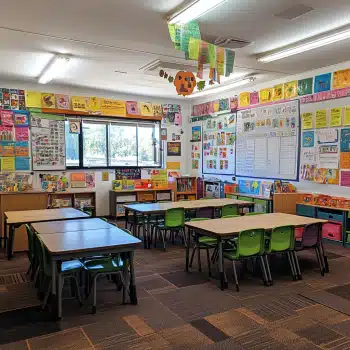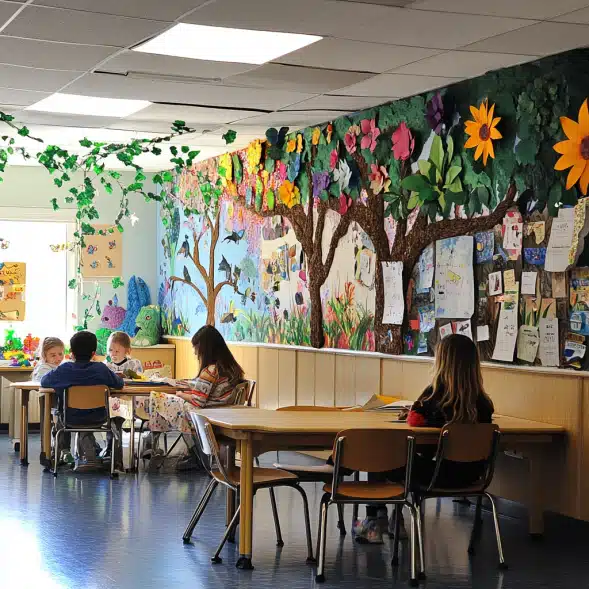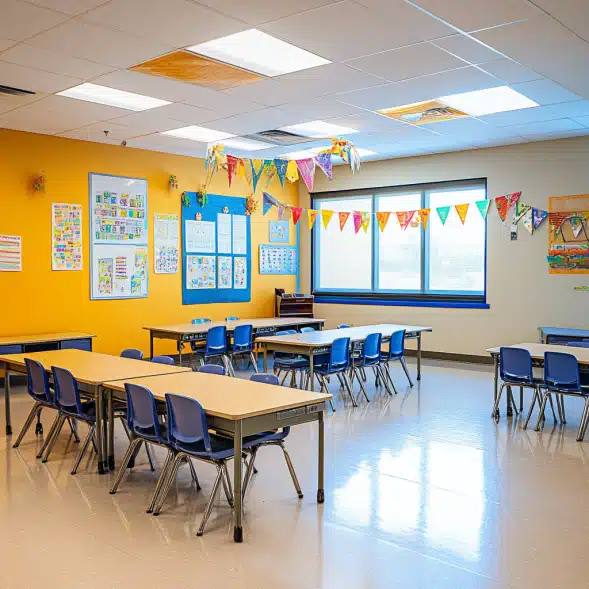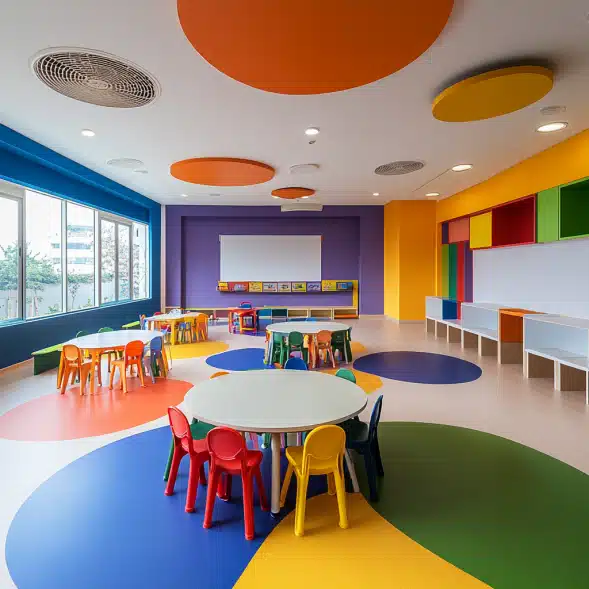Decorating the Classroom
Creative Strategies for an Inspiring Learning Environment
Benefits of Decorating the Classroom: Beyond Aesthetics
Decorating the classroom isn’t just about making the space look nice; it goes far beyond aesthetics. A well-decorated learning environment can have a significant impact on students’ emotional well-being, motivation, and academic performance. Creating a visually appealing and functional space is a strategy that can transform classroom dynamics and foster a positive and stimulating environment for learning.
One of the most important benefits of decorating the classroom is that it helps create a welcoming and safe environment for students. When students enter a well-decorated classroom, they feel welcomed and valued. A thoughtfully designed space sends a message that their education and well-being are important. This sense of belonging and safety is crucial for students to feel comfortable participating actively in class, expressing their ideas, and taking risks in their learning. A positive environment can also reduce anxiety and stress, helping students focus and concentrate better on academic tasks.
In addition, strategically decorating the classroom can help improve student motivation and engagement. The colors, themes, and visual materials used in decoration can inspire students and keep their interest in school activities. For example, using bright and stimulating colors can energize students and help maintain their attention, while themes related to subject content can spark curiosity and a desire to learn. Educational murals, inspiring quotes, and displays of student work not only beautify the space but also reinforce learning goals and remind students of their achievements and capabilities.
Another key benefit of decorating the classroom is that it can facilitate organization and the flow of activities in the classroom. Well-planned decoration includes the proper arrangement of furniture, the creation of specific areas for different activities, and the use of visual resources to guide students in their daily work. For example, a cozy reading corner with attractive décor can encourage students to enjoy independent reading. Similarly, a well-defined and decorated group work area can promote collaboration and teamwork. By organizing the space functionally, decoration helps create an environment where learning activities run smoothly and effectively.
Decorating the classroom also provides an opportunity to involve students in creating their learning environment. When students participate in decorating the classroom, whether through creating murals, selecting themes, or making posters, they feel more connected to the space and more responsible for its care. This sense of ownership can increase their motivation and willingness to contribute positively to the classroom. Additionally, working together on decoration projects fosters creativity, collaboration, and a sense of community among students.
Finally, decorating the classroom appropriately can support learning by providing students with visual stimuli and resources that reinforce the content being taught. Educational posters, maps, charts, and other visual tools not only decorate the classroom but also serve as constant references for students. These visual resources can help students remember key concepts, better understand complex topics, and make connections between different areas of knowledge.
In summary, decorating the classroom is a strategy that goes far beyond simple aesthetics. A well-decorated classroom can positively influence students’ emotional well-being, motivation, and academic performance, creating a learning environment that is both inspiring and functional. By carefully considering how to decorate the classroom, educators can create a space that truly supports and enriches students’ educational experience.

How to Decorate the Classroom to Foster Learning and Participation?
Decorating the classroom strategically is a powerful tool for promoting both learning and student participation. A well-designed environment can influence how students interact with the space, resources, and each other, fostering a more dynamic and effective educational experience. Below are some ideas and approaches for decorating the classroom in ways that enhance these key areas.
One of the most important aspects to consider when decorating the classroom is the arrangement of the furniture. The physical organization of the space can greatly impact how students learn and participate. For example, arranging desks in groups or in a U-shape can facilitate student interaction, encouraging teamwork and discussion. This setup is especially useful for activities that require collaboration or in classes where active participation from all students is to be expected. Additionally, a flexible furniture arrangement that allows for the space to be reconfigured according to the needs of each activity can make the classroom a more adaptable and functional place.
Another key element in decoration is the use of colors and themes that stimulate learning. Colors not only have an aesthetic impact, but they can also influence students’ moods and concentration. For instance, blue and green tones can create a calm and relaxing atmosphere, while warmer colors like yellow and orange can energize and stimulate creativity. When decorating the classroom, it’s helpful to choose a color palette that complements the type of activities that will take place in the room and that suits the students’ ages and needs. Incorporating visual themes related to the curriculum can also help keep students focused and connected to the lesson content.
Visual resources are another essential component when decorating the classroom to foster learning and participation. The classroom walls can become educational tools if used to display maps, charts, timelines, and other materials related to the subjects being taught. These resources not only decorate the space but also provide constant references that students can consult during lessons. Additionally, creating dedicated spaces, such as a keyword wall or a reading corner, can serve as specific learning centers that students can use independently.
Involving students in the decoration of the classroom is also an effective strategy to increase their engagement with learning. By involving students in the process of decorating the classroom, they are given the opportunity to express their creativity and take an active role in creating their learning environment. For example, students can contribute by creating murals, making posters, or choosing decorative themes that they find interesting and relevant. This approach not only personalizes the classroom but also fosters a sense of ownership and responsibility toward the shared space.
Additionally, it is important to consider the functionality and accessibility of materials and resources when decorating the classroom. Ensuring that educational materials, such as books, writing tools, and technology, are organized and within students’ reach can facilitate their use and promote more autonomous learning. Well-organized spaces not only improve the flow of activities but also help students develop organizational skills and feel more responsible for their learning environment.
Finally, rotating and updating the decor is crucial to maintaining student interest and motivation throughout the school year. Changing decorative themes according to the season, holidays, or current study topics can revitalize the space and keep students engaged. Moreover, by updating the decor, new resources and materials can be introduced to support current lessons, ensuring that the classroom remains a stimulating and relevant environment.
In summary, decorating the classroom in a way that fosters learning and participation involves a combination of strategic furniture arrangement, conscious use of color and visual resources, and active student participation in creating the space. By creating an environment that is attractive, functional, and adaptable, academic performance and student engagement can be enhanced, making the classroom a place where learning and participation naturally flourish.

Creative Ideas for Decorating the Classroom by Age and Academic Level
Decorating the classroom creatively and appropriately for the age and academic level of the students is essential for creating a learning environment that is not only attractive but also effective. Each educational stage has its own needs and characteristics, and the classroom decor should reflect these differences to support the development and learning of students. Below are some ideas for decorating the classroom, tailored to different ages and academic levels.
For early childhood students, decorating the classroom with colorful and stimulating elements is essential to capture their attention and foster their curiosity. At this age, children respond well to visually rich environments full of stimuli. Themes related to nature, animals, or characters from children’s stories can be used to create a cozy and familiar atmosphere. It is recommended to include differentiated learning areas, such as a reading corner with cushions and illustrated books, or an art zone with materials within the children’s reach. Additionally, the walls can be decorated with large letters and numbers, helping young children familiarize themselves with the alphabet and basic math concepts in a playful way. Involving the children in creating the decor, such as making murals or posters, can also be a great way to develop their creativity and sense of belonging to the classroom.
As students move on to elementary education, it is important for the classroom decor to evolve to reflect their growing skills and knowledge. Decorating the classroom for elementary students can include more structured themes, such as space, history, or science, that align with the subjects they are learning in their lessons. The colors should still be vibrant and attractive, but can be more sophisticated than in early childhood classrooms. Visual resources like maps, timelines, and charts can become active learning tools in the classroom decor. Additionally, specific areas can be created for different subjects, such as a math corner with logic games or a science area with simple experiments. Personalizing the space is also key; allowing students to display their projects or work on the walls can motivate them and make them feel proud of their achievements.
For secondary education students, classroom decor should adapt to their growing independence and critical thinking abilities. Decorating the classroom for teenagers requires a more mature approach, with a design that reflects a more serious study environment geared towards future preparation. Decorative themes can focus on motivation, critical thinking, and the exploration of more complex ideas. Murals or posters with inspiring quotes, images of historical or scientific figures, and advanced charts can serve as visual reminders of the academic purpose of the classroom. Additionally, creating spaces that encourage debate and discussion, such as areas with circle seating or group work tables, can be very beneficial. At this stage, it is essential for the decor to also promote organization and planning, so incorporating calendars, bulletin boards with important dates, and spaces for notes or reminders can help students stay focused and in control of their academic responsibilities.
Finally, for pre-university or high school students, classroom decor can evolve towards an even more sophisticated and future-oriented style. Decorating the classroom in this context can include elements that prepare them for life beyond school, such as information about universities, careers, and life skills. A more minimalist visual environment, with neutral colors and a focus on functionality, may be suitable for these more mature students. The walls can be adorned with infographics on topics of interest, maps of academic or career paths, and resources that encourage independent thinking and long-term planning.
In summary, decorating the classroom according to age and academic level is crucial for creating an environment that supports students’ learning and development at each stage of their education. From vibrant colors and playful themes in early childhood education to more sophisticated and future-oriented designs in secondary education, classroom decor should evolve to reflect the changing needs of students, helping them feel connected, motivated, and prepared to learn.

Common Mistakes When Decorating the Classroom and How to Avoid Them?
Decorating the classroom can be an exciting and creative task, but it also presents challenges that, if not addressed properly, can lead to mistakes that negatively affect the learning environment. It is important to consider certain key aspects to avoid falling into these common mistakes and instead create a space that truly benefits the students. Below are some of the most frequent mistakes when decorating the classroom and how to avoid them to ensure an effective and attractive educational environment.
One of the most common mistakes when decorating the classroom is overloading the space with too many visual elements. While it may be tempting to fill the walls with posters, charts, murals, and other resources, excessive decoration can become a distraction for students. Too much visual stimulation can make it difficult to concentrate and can make the classroom feel cluttered and chaotic. To avoid this mistake, it is essential to adopt a more minimalist and selective approach. Instead of covering all surfaces with information, it is better to carefully choose elements that truly support the students’ learning and motivation. A proper balance between decorated spaces and clear areas can help create a calmer and more focused environment.
Another frequent mistake is not considering the functionality of the space when decorating the classroom. The arrangement of furniture and decorative elements should facilitate the flow of activities and movement within the classroom. Placing furniture in a way that obstructs movement or hinders visibility of the teacher and educational resources can interfere with the class dynamics. To avoid this problem, it is important to plan the classroom layout so that all students have a clear view of the board or screen and that there is enough space to move comfortably. The decoration should complement this arrangement, ensuring that visual resources are accessible and visible to everyone.
A third mistake when decorating the classroom is not adapting the decor to the students’ needs and ages. What may be appropriate and attractive for young children may not necessarily work for teenagers, and vice versa. Decorating a high school classroom with overly childish colors and themes can make students feel disconnected and uncomfortable in their environment. On the other hand, a decoration that is too serious or minimalist may not capture the attention of younger students. To avoid this mistake, it is crucial to consider the students’ age, academic level, and interests when choosing colors, themes, and decorative resources. Involving students in the decoration process can be an excellent way to ensure that the classroom reflects their tastes and needs.
Another common mistake is not leaving room for personalization and flexibility. When decorating the classroom, it is easy to fall into the trap of creating a design that is too rigid or static, with no room for changes or additions throughout the year. However, it is important for the classroom to be a constantly evolving space that can adapt to new study units, special projects, or even changes in group dynamics. To avoid this mistake, it is recommended to leave dedicated areas to display students’ work, to change the decor according to seasons or current themes, and to adjust the furniture according to the activities being carried out. Flexibility in decoration allows the classroom to remain a lively and relevant space throughout the school year.
Finally, a mistake that is often involved when decorating the classroom is ignoring the impact of lighting on the classroom environment. Light plays a crucial role in how students perceive and feel in their surroundings. A poorly lit classroom can feel dull and uninviting, while excessively bright lighting can cause eye strain. To avoid this mistake, it is important to consider both natural and artificial light when planning the decoration. The use of curtains, lamps, and other elements can help control the amount of light and create a warm and comfortable environment that supports learning.
In summary, successfully decorating the classroom involves avoiding common mistakes such as visual overload, lack of functionality, inadequate adaptation to students’ ages, lack of flexibility, and poor lighting. By addressing these aspects consciously, it is possible to create a space that is not only aesthetically pleasing but also effectively supports the well-being and learning of students.

For more information visit 1A Classroom.
